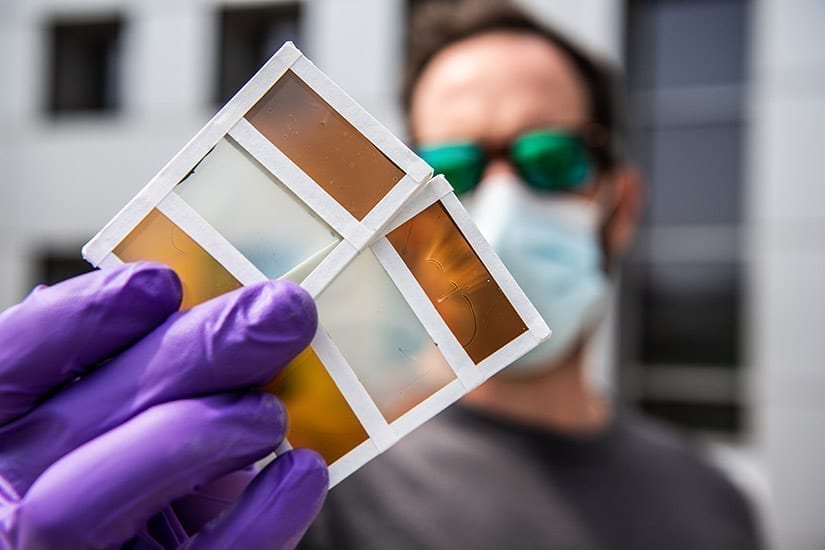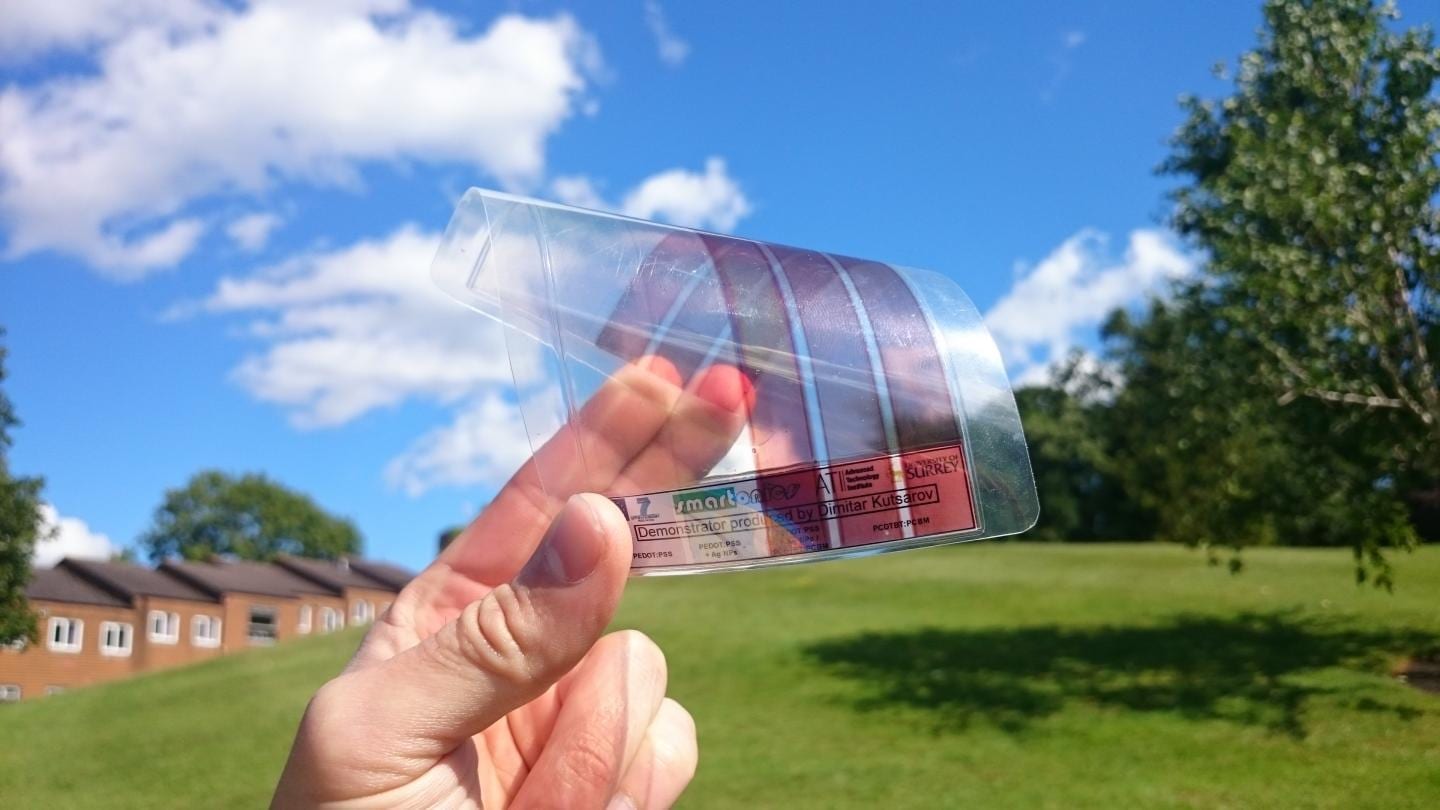
NREL researcher Lance Wheeler holds samples of perovskite-based window technology. Photo by Dennis Schroeder, NREL
Research Developments Create Faster Changes at Lower Temperatures, More Colors
Scientists at the U.S. Department of Energy’s National Renewable Energy Laboratory (NREL) report a breakthrough in developing a next-generation thermochromic window that not only reduces the need for air conditioning but simultaneously generates electricity.
Heat generated by sunlight shining through windows is the single largest contributor to the need for air conditioning and cooling in buildings. Because residential and commercial buildings use 74% of all electricity and 39% of all energy in the United States, the shading effect from tinting windows helps buildings use less energy.
The technology, termed “thermochromic photovoltaic,” allows the window to change color to block glare and reduce unwanted solar heating when the glass gets warm on a hot, sunny day. This color change also leads to the formation of a functioning solar cell that generates on-board power. Thermochromic photovoltaic windows can help buildings turn into energy generators, increasing their contribution to the broader energy grid’s needs. The newest breakthrough now enables myriad colors and a broader range of temperatures that drive the color switch. This increases design flexibility for improving energy efficiency as well as control over building aesthetics that is highly desirable for both architects and end users.
The research builds upon earlier work at NREL into a thermochromic window that darkened as the sun heated its surface. As the window shifted from transparent to tinted, perovskites embedded within the material generated electricity. Perovskites are a crystalline structure shown to have remarkable efficiency at harnessing sunlight.
“A prototype window using the technology could be developed within a year,” said Bryan Rosales, a postdoctoral researcher at NREL and lead author of the paper, “Reversible Multicolor Chromism in Layered Formamidinium Metal Halide Perovskites,” which appears in the journal Nature Communications. His co-authors from NREL are Lance Wheeler, who developed the first thermochromic photovoltaic window, Taylor Allen, David Moore, Kevin Prince, Garry Rumbles, and Laura Schelhas. Other authors are Laura Mundt from SLAC National Accelerator Laboratory, and Colin Wolden from Colorado School of Mines.
The first-generation solar window was able to switch back and forth between transparent and a reddish-brown color, requiring temperatures between 150 degrees and 175 degrees Fahrenheit to trigger the transformation. The latest iteration allows a broad choice of colors and works at 95 degrees to 115 degrees Fahrenheit, a glass temperature easily achieved on a hot day.
By using a different chemical composition and materials, the researchers also were able to rapidly speed up the color transformation. The time was reduced to about seven seconds from the three minutes it took during the proof-of-concept thermochromic photovoltaic window demonstrated in 2017.
The scientists sandwiched a thin perovskite film between two layers of glass and injected vapor. The vapor triggers a reaction that causes the perovskite to arrange itself into different shapes, from a chain to a sheet to a cube. The colors emerge with the changing shapes. Lowering the humidity returns the perovskite to its normal transparent state.
Additional research is planned. One area to be explored is the number of times the thermochromic window can be cycled into an electricity-generating operating mode and return to transparent. The efficiency of converting sunlight into electricity will also be explored.
The Latest Updates from Bing News & Google News
Go deeper with Bing News on:
Thermochromic window
- How Much Does Window Cleaning Cost in 2024?
Faith Wakefield is a writer based in North Carolina. She holds economics and English degrees from UNC Chapel Hill, and her work has been featured on EcoWatch, The World Economic Forum and Today ...
- How Much Does a Window Screen Replacement Cost in 2024?
Window screen prices vary depending on where you live. If the cost of living in your area is above the national average, you will likely pay more for your window screens. When replacing your ...
- The 4 Best Window Replacement Companies of May 2024
Whether a homeowner places more importance on their home’s exterior aesthetics or level of interior comfort, the windows they choose play a very important role. Ugly, dated, damaged, and rotting ...
- 13 important Windows settings to adjust immediately
Windows has been hiding known file extensions for years by default. This is initially annoying because it means that the correct file name is not displayed in full. There is also the security risk ...
- How Much Does a Bow Window Cost? | 2024 Guide
A bow window is an arc-shaped window that extends outward from the home. They’re typically comprised of four or more equally sized casement windows and are often referred to by the number of ...
Go deeper with Google Headlines on:
Thermochromic window
[google_news title=”” keyword=”thermochromic window” num_posts=”5″ blurb_length=”0″ show_thumb=”left”]
Go deeper with Bing News on:
Thermochromic photovoltaic windows
- Connecticut Solar Panel Incentives: Tax Breaks, Net Metering and More
Since 2010, Connecticut has offered a sales tax exemption on all renewable energy equipment, including solar. (The rebate also applies to things like geothermal and wind power). This would save you ...
- Best Solar Panels For Homes Of 2024
For product selection, we evaluated the top solar panel providers and compiled this list of the best solar panels for home to help you make an informed decision. Why you can trust Forbes Home for ...
- Mask-inspired perovskite smart windows enhance weather resistance and energy efficiency
Thermochromic perovskite is a new color switch material used in energy-saving smart windows. Despite its potential for energy savings, thermochromic perovskite suffers from poor weather resistance, ...
- Best Windows Laptop for 2024
Matt Elliott is a senior editor at CNET with a focus on laptops and streaming services. Matt has more than 20 years of experience testing and reviewing laptops. He has worked for CNET in New York ...
- The Only Solar Shingles Buying Guide You Need
Solar shingles, or solar roof tiles, are made of slim photovoltaic (PV) sheets that either overlay or replace the existing shingles on a roof. They absorb sunlight and convert it into electricity.
Go deeper with Google Headlines on:
Thermochromic photovoltaic windows
[google_news title=”” keyword=”thermochromic photovoltaic windows ” num_posts=”5″ blurb_length=”0″ show_thumb=”left”]










